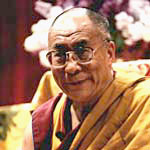
![]()
The Different organization of Buddhism
The teaching of Buddha is the basic education towards the cultivation of the mind. The Buddha has taught all over India and have numerous disciples (bhikkus and bhikkunis) monks and nuns during his lifetime to spread the teaching of the wisdom. Many of the disciples having gained wisdom do attain to be enlightened, to be Arahat (Saint) meaning 'Capable One' who has escaped the Cycle of Sufferings.
At the time of The Buddha's passing to parinirvana, there was 500 Arahat in this earth who followed Buddha's teachings. The Buddha in his lifetime has established the Noble Order of the Sangha or community of monks that still exist to this day. His Teachings (Dhamma) became the sole guide and source to the Sangha. However, the vast teachings together with their profound it brought about different understanding and interpretations that two main schools of thought came into being.

The First Buddhist Council (gathering of the Sangha) was held right after the Buddha's passing was hosted by Maha Kasyappa, an Arahant, the First Patriarch of Buddhism to collect the teachings of Buddha and to compile it in written form. 500 Arahant attended the Council and the Pali Canon, the teachings that the Hinayana sect follows was born.
At the Second Buddhist Council held some 100 years later 2 great traditions of sects was formally formed that is the Hinayana and Mahayana. The two great traditions share the same basic teachings of the Buddha but different in path.
The Hinayana known as 'Little Raft' focuses on the attainment of enlightenment for one self to become an Arahant. While the Mahayana known as 'Great Vehicle' strives not only for self liberation but also to serve mankind to choose to attain enlightenment thru the Boddhisattva path. Boddhisattva means that delaying enlightenment to help in salvation of other beings. It is open to practice to all including monks and lay people that has won the hearts of countless people especialy in China.
Both traditions follows different scriptures and path to enlightenment but holds the basic teachings of Buddha. Hinayana later known as Theravada (Way of the Elders) spread from India to Sri Lanka, Thailand, Burma, and Laos. Their schools suffer decline from 18 major ones to only one left today. The Mahayana on the other hand was greatly accepted to China, Mongolia, Japan, Tibet, Nepal, Sikkim and Bhutan. They are 8 major schools in China and another divide happened within this tradition around the 8th century.
The Vajrayana is an offshoot of Mahayana Buddhism that accepted the Tantric practice into Buddhism and emphasis on mainly ritualistic ceremonial actions which involve the body, speech and mind for salvation. It originated in Tibet when Buddhism went into decline due to foreign invasion in India, Tibetians was ready to serve as the center of Buddhism because it was well equipped with sutras and schools at that period. They are 4 main schools in Vajrayana traditions, and The Dalai Lama is one of them. the Vajrayana is well- known in the west today because of it's teaching of mantras that is associated to drive off evils.

Previous Next
![]() This
is a thesis website by ressox studio.
This
is a thesis website by ressox studio.

